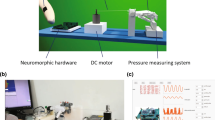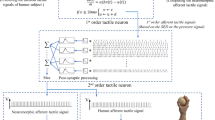Abstract
In comparison with robot manipulators, primate limbs excel robots in facile movements requiring compliance control. Based on this fact, a neuromuscular-like model that can emulate different involuntary and voluntary movements within constraints from neurophysiology is proposed in this paper. The neural controller is an intelligent system applied for multi-joint opponent muscle control of a robot finger. Artificial muscles are electric pistons with shape memory alloy (SMA) springs. The neural model proposes functional roles for pre-central cortical cell types in the computation of a descending command to spinal alpha and gamma motor neurons, and allows controlling desired joint movement trajectories by smoothly interpolating between initial and final muscle length commands for the antagonist muscles involved in the movement. Through experimental results, we showed that the neural controller exhibits key kinematic properties of human joint movements, dynamics compensation and including asymmetric bell-shaped velocity profiles. The neural controller allows varying the balance of static and dynamic feedback information to guide the joints’ movement command and to compensate external forces.
Preview
Unable to display preview. Download preview PDF.
Similar content being viewed by others
References
Wu, C.H., Hwang, K.S., Chang, S.L.: Analysis and implementation of a neuromuscular-like control for robotic compliance. IEEE Transactions on Control Systems Technology 5, 586–597 (1997)
He, J., Maltenfort, M.G., Wang, Q., Hamm, T.M.: Learning from biological systems: Modeling neural control. IEEE Control systems Magazine, 55–69 (2001)
Lan, N., Li, Y., Sun, Y., Yang, F.S.: Reflex regulation of antagonist muscles for control of joint equilibrium position. IEEE Transactions on Neural Systems and Rehabilitation engineering 13, 60–71 (2005)
Jacobsen, S.C., Wood, J.E., Knutti, D.F., Biggers, K.B.: The Utah/MIT dextrous hand: Work in progress. The International Journal of Robotics Research 3, 21–50 (1984)
Scott, S.H., Kalaska, J.F.: Changes in motor cortex activity during reaching movements with similar hand paths but different arm postures. Journal of Neurophysiology 73, 2563–2567 (1995)
Riehle, A., Mackay, W.A., Requin, J.: Are extent and force independent movement parameters? Preparation-and movement-related neuronal activity in the monkey cortex. Experimental Brain Research 99, 56–74 (1994)
Bullock, D., Cisek, P., Grossberg, S.: Cortical networks for control voluntary arm movements under variable force conditions. Cerebral Cortex 8, 48–62 (1998)
Gorbet, R.B., Wang, D.W.L.: A dissipativity approach to stability of a shape memory alloy position control system. IEEE Transactions on Control Systems Technology 6, 554–562 (1998)
Madill, D.R., Wang, D.: Modeling and L2-stability of a shape memory alloy position control system. IEEE Transactions on Control Systems Technology 6, 473–481 (1998)
Bullock, D., Grossberg, S.: VITE and FLETE: Neural modules for trajectory formation and tension control. In: Hershberger, W.A. (ed.) Volitional Action, pp. 253–297. North-Holland, Amsterdam (1989)
Kalaska, J.F., Cohen, D.A.D., Hyde, M.L., Prud’homme, M.: A comparison of movement direction- related versus load direction-related activity in primate motor cortex, using a two-dimensional reaching task. Journal of Neuroscience 9, 2080–2102 (1989)
Contreras-Vidal, J.L., Grossberg, S., Bullock, D.: Neural model of cerebellar learning for arm movement control: Cortico-spino-cerebellar dynamics. Learn Memory 3, 475–502 (1997)
Spoelstra, J., Schweighofer, N., Arbib, M.A.: Cerebellar learning of accurate predictive control for fast-reaching movements. Biological Cybernetics 82, 321–333 (2000)
Author information
Authors and Affiliations
Editor information
Editors and Affiliations
Rights and permissions
Copyright information
© 2006 Springer-Verlag Berlin Heidelberg
About this paper
Cite this paper
García-Córdova, F., Mulero-Martínez, J.I. (2006). Neuromuscular-Like Control for an Artificial Finger with SMA Actuators. In: Sattar, A., Kang, Bh. (eds) AI 2006: Advances in Artificial Intelligence. AI 2006. Lecture Notes in Computer Science(), vol 4304. Springer, Berlin, Heidelberg. https://doi.org/10.1007/11941439_72
Download citation
DOI: https://doi.org/10.1007/11941439_72
Publisher Name: Springer, Berlin, Heidelberg
Print ISBN: 978-3-540-49787-5
Online ISBN: 978-3-540-49788-2
eBook Packages: Computer ScienceComputer Science (R0)




